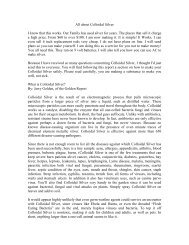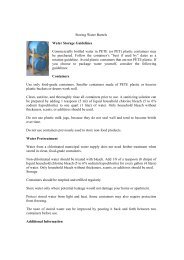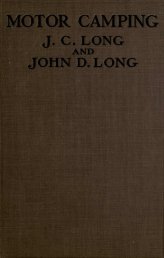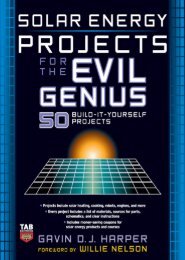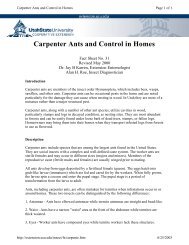Build Your Own Solar Evaporative Cooler - Survival-training.info
Build Your Own Solar Evaporative Cooler - Survival-training.info
Build Your Own Solar Evaporative Cooler - Survival-training.info
You also want an ePaper? Increase the reach of your titles
YUMPU automatically turns print PDFs into web optimized ePapers that Google loves.
<strong>Build</strong> <strong>Your</strong> <strong>Own</strong> <strong>Solar</strong> <strong>Evaporative</strong> <strong>Cooler</strong><br />
By: Jim Eddy - Susanville, California<br />
I live in an all solar house in Northern California. It is a passive design so<br />
the sun heats it by shining in the windows. I solar heat our water and have a 1<br />
kilowatt solar electric charging system providing 110 volts of AC power. The one<br />
thing I could not do was cool the house easily in the summer without taxing the<br />
system. I purchased an evaporative type unit for indoors but it did not do much<br />
good. A compressor type air conditioner would use more energy than I could<br />
supply and a regular evaporative cooler would use a lot of energy. I figured that<br />
some sort of solar cooler could do the trick.<br />
I spent sometime looking for a solar evaporative cooler on the Internet.<br />
Those that I found were bulky, ugly and expensive. Most cost around $ 600.00 and<br />
up. The above pictures are of a <strong>Solar</strong> evaporative cooler that I made using easily<br />
purchased components to cool our 1600 square foot house. I spent roughly $300 to<br />
make this unit. It is in it’s fourth year of use. If you have some of the components<br />
already you could spend much less. The cost of a new solar panel to power the unit<br />
is around $550 and can be purchased at many local or on line stores.<br />
Afternoon Summer temperatures range between 85° to 95° in this part of<br />
California. The cooler that I purchased is smaller than I should have for my house<br />
size, but it does a good job of keeping the house cool. With the fan and pump<br />
modifications, it maintains a temperature difference of about 15° between the<br />
outside and the inside. As I am writing this it is 4:30 in the afternoon. The outside<br />
temperature is 92° and the inside temperature is 77°. Anyone with an existing<br />
evaporative cooler of any size can make a similar looking cooler, or you can buy<br />
one like I did.<br />
1 www.livingonsolar.com
I decided to use an existing evaporative cooler because I didn’t want to reinvent<br />
the wheel. All the components are already there, the cooler pads, a trough to<br />
hold water, a float valve to let more water in and a water distribution system. As<br />
you can see from the pictures I<br />
mounted a 12 volt radiator fan in front<br />
of the existing opening and I opted to<br />
leave the existing AC pump, motor and<br />
squirrel cage intact. Since I have 110<br />
Volt AC power available at my house,<br />
on occasions, I use the existing AC<br />
pump and motor after the sun has gone<br />
down to continue cooling the house. I<br />
was concerned that leaving everything<br />
there might significantly block the<br />
airflow, but it seems to work just fine.<br />
You could remove the existing motor<br />
and pump and It might work even<br />
better. If you do use the AC fan, make<br />
sure the 12 Volt fan does not turn as it<br />
could cause it to burn out. I use a coat<br />
hanger inserted through the front and<br />
placed between the 12 Volt fan blades<br />
and it’s housing. It seems a little hoaky<br />
but it keeps the fan from turning.<br />
I purchased the electric radiator fan at a local auto parts store. I paid around<br />
$80 for it and have seen similar fans on the Internet for $35. The pump is a 12 volt<br />
bilge pump that I purchased at Wal Mart for around $14. Make sure that you don’t<br />
use too strong of a pump or you will blast the water into the feeder tubes.<br />
At full speed the fan pulls 5.5amps @ 12 volts. The bilge pump pulls around<br />
1.5 amps @ 12 volts. A 100 watt solar panel will power the fan and pump nicely. I<br />
am using a Mitsubishi 110 Watt panel that is mounted on a solar tracker that I<br />
made. The panel and tracker are mounted on the ground in front of the cooler. In<br />
previous years I have placed the panel flat on the roof just above the cooler. That<br />
worked fine for most of the day. The tracker extends the time in the afternoon<br />
when the summer temperatures are keeping things hot.<br />
You can decide for yourself how you want to mount the fan. I drilled holes in<br />
the sheet metal and used sheet metal screws to attach it. I did have to do some<br />
cutting of the sheet metal with a Dremel tool to make it fit. Radiator fans can be<br />
2 www.livingonsolar.com
hooked up two ways electrically so the fan can blow air in either direction. Make<br />
sure you hook it up correctly to blow the direction you want.<br />
I removed the existing front cover to expose the opening. I then placed the fan over<br />
the opening to determine the best fit and drilled holes in the sheet metal.<br />
I opted to leave the cover in tact as much as possible so I had to fit the fan back<br />
into the cover before mounting everything to the main housing. It was a tight fit!<br />
After sliding the fan into the cover, I mounted both onto the main housing with the<br />
existing sheet metal screws and 4 new ones for the fan.<br />
3 www.livingonsolar.com
The bilge pump can be placed in the water right alongside of the existing AC<br />
pump. You can disconnect the hose from the existing pump and place it on the<br />
bilge pump. You may have to use additional hose and an adapter like I did.<br />
I mounted two new rocker switches to the front of the existing cover on the side<br />
opposite of the existing switches. I was able to drill holes in the plastic and they<br />
mounted nicely.<br />
The finished front installed inside.<br />
The panel and tracker that I use.<br />
4 www.livingonsolar.com
Wiring the solar panel to the fan and pump is relatively easy if you have<br />
some experience. <strong>Solar</strong> panels have different types of connectors depending on<br />
which kind that you have. Some have junction boxes that allow wire to be placed<br />
into the box and a secure connection made. Newer panels have MC connectors<br />
which allow for a snap fit for multiple panel connections. These would probably<br />
have to be cut to connect the wire. The better way to do this is to buy an MC<br />
extension which has both male and female ends on it. It can be cut in half and then<br />
connected to the panel and then to the wire. I used wire connectors that were<br />
crimped to the positive and negative wires and then to the fan and pump wires and<br />
switches. When I placed my panels directly on the roof I ran the positive and<br />
negative wires over the eave and along the outside wall to the cooler. I placed the<br />
wire in flex tubing to make a neat job. There was an existing hole on the top corner<br />
of the cooler that I could run the wires into. The negative wire went to a common<br />
ground which then went to the fan and pump. The positive wire was run to the two<br />
switches that control the fan and pump. The wires were passed through an opening<br />
between the inside of the cooler and the portion that goes into the window where<br />
the existing 110 AC volt wires were run. They were connected to the switches and<br />
back to the fan and pump. I used tie connectors to keep the wires in place and neat.<br />
I do not use a voltage regulator on my cooler. The fan and pump seem to work fine<br />
without it. There are some panels that have built in regulators. They might function<br />
the best.<br />
A LITTLE ABOUT EVAPORATIVE COOLERS<br />
<strong>Evaporative</strong> coolers perform best when the humidity is low. On days when<br />
the humidity is really high, the house can feel muggy inside. For those who have<br />
another type of air conditioning system, that will be the time to use it. For the drier<br />
days the evaporative cooler can do quite well. If you can, place the cooler in a<br />
window that is shaded. The sun baking on the metal surface can reduce the<br />
effectiveness. I actually don’t have mine shaded, but you should do what I say and<br />
not what I do.<br />
<strong>Evaporative</strong> coolers draw air from the outside and as it passes through the<br />
pads it is cooled and blown into the house. It is best to close all the windows in the<br />
house except for one that is farthest from the cooler. I open the back bathroom<br />
window about half way. You can feel the air exiting the house at the window. I<br />
place a piece of toilet paper up to the screen and it will stay in place from the<br />
exiting air.<br />
The cooler is a little noisy and it can be irritating when the sun goes behind a<br />
cloud and the fan slows down and then speeds up when the cloud goes away.<br />
5 www.livingonsolar.com
The following is a partial list of items that you will need.<br />
Materials: Purchased at: Price<br />
New Evap cooler 3000CFM Wal Mart, Lowes,<br />
Home Depot $ 200-300<br />
Evap cooler you have Home $ 0<br />
12 Volt radiator fan Internet, Kragen’s $ 35-80<br />
12 Volt bilge pump Wal Mart $ 14<br />
(2) 12 Volt switches Radio Shack - Kragen’s $ 4 ea<br />
12 gauge wire Radio Shack - Kragens $ 10/25feet<br />
Additional hose for pump Hardware store $ 2<br />
75 to 125 watt 12 Volt solar panel Internet $ 400-600<br />
Wire connectors, flex tubing to cover wires, sheet metal screws, fuse and<br />
fuse holder, tie straps to make a neat job and keep wires in place. Good Luck!<br />
6 www.livingonsolar.com



